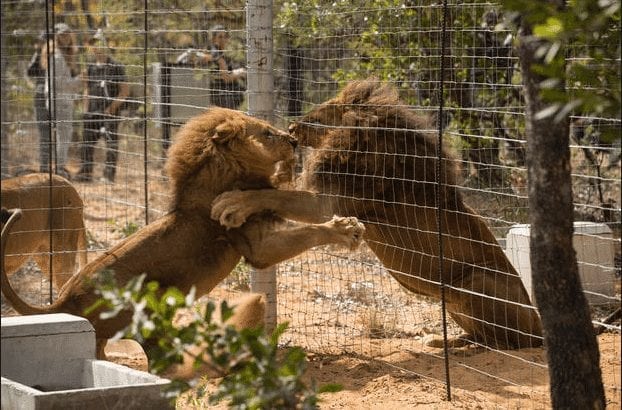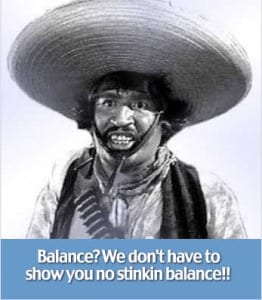The Case for Animal Rights
By Tom Regan
Excerpted from ANIMAL RIGHTS AND HUMAN OBLIGATIONS
 Edited by Tom Regan and Peter Singer. Second edition / Englewood Cliffs, NJ, Prentice Hall, 1989 ISBN # 0-13-036864-4
Edited by Tom Regan and Peter Singer. Second edition / Englewood Cliffs, NJ, Prentice Hall, 1989 ISBN # 0-13-036864-4
How to proceed? We begin by asking how the moral status of animals has been understood by thinkers who deny that animals have rights. Then we test the mettle of their ideas by seeing how well they stand up under the heat of fair criticism. If we start our thinking in this way we soon find that some people believe that we have no duties directly to animals, that we owe nothing to them that we can do nothing that wrongs them. Rather we can do wrong acts that involve animals and so we have duties regarding them though none to them. Such views may be called indirect duty views. By way of illustration — suppose your neighbor kicks your dog. Then your neighbor has done something wrong, but not to your dog. The wrong that has been done is a wrong to you. After all it is wrong to upset people and your neighbor’s kicking your dog upsets you so you are the one who is wronged not your dog Or again — by kicking your dog your neighbor damages your property. And since it is wrong to damage another person’s property, your neighbor has done something wrong — to you, of course, not to your dog. Your neighbor no more wrongs your dog than your car would be wronged if the windshield were smashed. Your neighbor’s duties involving your dog are indirect duties to you. More generally, all of our duties regarding animals are indirect duties to one another — to humanity.
How could someone try to justify such a view? Someone might say that your dog doesn’t feel anything and so isn’t hurt by your neighbor’s kick, doesn’t care about the pain since none is felt, is as unaware of anything as is your windshield. Someone might say this, but no rational person will, since, among other considerations, such a view will commit anyone who holds it to the position that no human beings feel pain either — that human beings also don’t care about what happens to them. A second possibility is that though both humans and your dog are hurt when kicked, it is only human pain that matters. But, again, no rational person can believe this. Pain is pain wherever it occurs. If your neighbor’s causing you pain is wrong because of the pain that is caused, we cannot rationally ignore or dismiss the moral relevance of the pain that your dog feels.
 [dropcap]P[/dropcap][dropcap][/dropcap]hilosophers who hold indirect duty views — and many still do — have come to understand that they must avoid the two defects just noted: that is, both the view that animals don’t feel anything as well as the idea that only human pain can be morally relevant. Among such thinkers the sort of view now favored is one or another form of what is called contractarianism.
[dropcap]P[/dropcap][dropcap][/dropcap]hilosophers who hold indirect duty views — and many still do — have come to understand that they must avoid the two defects just noted: that is, both the view that animals don’t feel anything as well as the idea that only human pain can be morally relevant. Among such thinkers the sort of view now favored is one or another form of what is called contractarianism.
Here, very crudely, is the root idea: morality consists of a set of rules that individuals voluntarily agree to abide by, as we do when we sign a contract (hence the name contractarianism). Those who understand and accept the terms of the contract are covered directly; they have rights created and recognized by, and protected in, the contract. And these contractors can also have protection spelled out for others who, though they lack the ability to understand morality and so cannot sign the contract themselves, are loved or cherished by those who can. Thus young children, for example, are unable to sign contracts and lack rights. But they are protected by the contract nonetheless because of the sentimental interests of others, most notably their parents. So we have, then, duties involving these children, duties regarding them, but no duties to them. Our duties in their case are indirect duties to other human beings, usually their parents.
As for animals, since they cannot understand contracts, they obviously cannot sign; and since they cannot sign, they have no rights. Like children, however, some animals are the object of the sentimental interest of others. You, for example, love your dog or cat. So those animals that enough people care about (companion animals, whales, baby seals, the American bald eagle), though they lack rights themselves, will be protected because of the sentimental interests of people. I have, then, according to contractaranism, no duty directly to your dog or any other animal, not even the duty not to cause them pain or suffering; my duty not to hurt them is a duty I have to those people who care about what happens to them. As for other animals, where no or little sentimental interest is present — in the case of farm animals, for example, or laboratory rats — what duties we have grow weaker and weaker, perhaps to the vanishing point. The pain and death they endure, though real, are not wrong if no one cares about them.
[dropcap]W[/dropcap]hen it comes to the moral status of animals, contractarianism could be a hard view to refute if it were an adequate theoretical approach to the moral status of human beings. It is not adequate in this latter respect, however, which makes the question of its adequacy in the former case, regarding animals, utterly moot. For consider: morality, according to the (crude) contractarian position before us, consists of rules that people agree to abide by. What people? Well, enough to make a difference — enough, that is, collectively to have the power to enforce the rules that are drawn up in the contract. That is very well and good for the signatories but not so good for anyone who is not asked to sign. And there is nothing in contractarianism of the sort we are discussing that guarantees or requires that everyone will have a chance to participate equally in framing rules of morality. The result is that this approach to ethics could sanction the most blatant forms of social, economic, moral, and political injustice, ranging from a repressive caste system to systematic racial or sexual discrimination. Might, according to this theory, does make right. Let those who are the victims of injustice suffer as they will. It matters not so long as no one else — no contractor, or too few of them — cares about it. Such a theory takes one’s moral breath away . . . as if, for example, there would be nothing wrong with apartheid in South Africa if few white South Africans were upset by it. A theory with so little to recommend it at the level of the ethics of our treatment of our fellow humans cannot have anything more to recommend it when it comes to the ethics of how we treat our fellow animals.
The version of contractarianism just examined is, as I have noted, a crude variety, and in fairness to those of a contractarian persuasion, it must be noted that much more refined, subtle, and ingenious varieties are possible. For example, John Rawls, in his A Theory of Justice, sets forth a version of contractarianism that forces contractors to ignore the accidental features of being a human being — for example, whether one is white or black, male or female, a genius or of modest intellect. Only by ignoring such features, Rawls believes, can we ensure that the principles of justice that contractors would agree upon are not based on bias or prejudice. Despite the improvement a view such as Rawls’s represents over the cruder forms of Contractarianism, it remains deficient: it systematically denies that we have direct duties to those human beings who do not have a sense of justice — young children, for instance, and many mentally retarded humans. And yet it seems reasonably certain that were we to torture a young child or a retarded elder, we would be doing something that wronged him or her, not something that would be wrong if (and only if) other humans with a sense of justice were upset. And since this is true in the case of these humans, we cannot rationally deny the same in the case of animals.
[dropcap]I[/dropcap]ndirect duty views, then, including the best among them, fail to command our rational assent. Whatever ethical theory we should accept rationally, therefore, it must at least recognize that we have some duties directly to animals, just as we have some duties directly to each other. The next two theories I’ll sketch attempt to meet this requirement.
The first I call the cruelty-kindness view. Simply stated, this says that we have a direct duty to be kind to animals and a direct duty not to be cruel to them. Despite the familiar, reassuring ring of these ideas, I do not believe that this view offers an adequate theory. To make this clearer, consider kindness. A kind person acts from a certain type of motive —compassion or concern, for example. And that is a virtue. But there is no guarantee that a kind act is a right act. If I am a generous racist, for example, I will be inclined to act kindly towards members of my own race, favoring their interests above those of others. My kindness would be real and, so far as it goes, good. But I trust it is too obvious to require argument that my kind acts may not be above moral reproach — may, in fact, be positively wrong because rooted in injustice. So kindness, notwithstanding its status as a virtue to be encouraged, simply will not carry the weight of a theory of right action.
Cruelty fares no better. People or their acts are cruel if they display either a lack of sympathy for or, worse, the presence of enjoyment in another’s suffering. Cruelty in all its guises is a bad thing, a tragic human failing. But just as a person’s being motivated by kindness does not guarantee that he or she does what is right, so the absence of cruelty does not ensure that he or she avoids doing what is wrong. Many people who perform abortions, for example, are not cruel, sadistic people. But that fact alone does not settle the terribly difficult question of the morality of abortion. The case is no different when we examine the ethics of our treatment of animals. So, yes, let us be for kindness and against cruelty. But let us not suppose that being for the one and against the other answers questions about moral right and wrong.
[dropcap]S[/dropcap]ome people think that the theory we are looking for is utilitarianism. A utilitarian accepts two moral principles. The first is that of equality: everyone’s interests count, and similar interests must be counted as having similar weight or importance. White or black, American or Iranian, human or animal — everyone’s pain or frustration matters, and matters just as much as the equivalent pain or frustration of anyone else. The second principle a utilitarian accepts is that of utility: do the act that will bring about the best balance between satisfaction and frustration for everyone affected by the outcome.
As a utilitarian, then, here is how I am to approach the task of deciding what I morally ought to do: I must ask who will be affected if I choose to do one thing rather than another, how much each individual will be affected, and where the best results are most likely to lie — which option, in other words, is most likely to bring about the best results, the best balance between satisfaction and frustration. That option, whatever it may be, is the one I ought to choose. That is where my moral duty lies.
The great appeal of utilitarianism rests with its uncompromising egalitarianism: everyone’s interests count and count as much as the like interests of everyone else. The kind of odious discrimination that some forms of contractarianism can justify — discrimination based on race or sex, for example — seems disallowed in principle by utilitarianism, as is speciesism, systematic discrimination based on species membership.
The equality we find in utilitarianism, however, is not the sort an advocate of animal or human rights should have in mind. Utilitarianism has no room for the equal rights of different individuals because it has no room for their equal inherent value or worth. What has value for the utilitarian is the satisfaction of an individual’s interests, not the individual whose interests they are. A universe in which you satisfy your desire for water, food, and warmth is, other things being equal, better than a universe in which these desires are frustrated. And the same is true in the case of an animal with similar desires. But neither you nor the animal have any value in your own right. Only your feelings do.
Here is an analogy to help make the philosophical point clearer: a cup contains different liquids, sometimes sweet, sometimes bitter, sometimes a mixture of the two. What has value are the liquids: the sweeter the better, the bitterer the worse. The cup, the container, has no value. It is what goes into it, not what they go into, that has value. For the utilitarian, you and I are like the cup; we have no value as individuals and thus no equal value. What has value is what goes into us, what we serve as receptacles for; our feelings of satisfaction have positive value, our feelings of frustration negative value.
Serious problems arise for utilitarianism when we remind ourselves that it enjoins us to bring about the best consequences. What does this mean? It doesn’t mean the best consequences for me alone, or for my family or friends, or any other person taken individually. No, what we must do is, roughly, as follows: we must add up (somehow!) the separate satisfactions and frustrations of everyone likely to be affected by our choice, the satisfactions in one column, the frustrations in the other. We must total each column for each of the options before us. That is what it means to say the theory is aggregative. And then we must choose that option which is most likely to bring about the best balance of totalled satisfactions over totalled frustrations. Whatever act would lead to this outcome is the one we ought morally to perform — it is where our moral duty lies. And thar act quite clearly might not be the same one that would bring about the best results for me personally, or for my family or friends, or for a lab animal. The best aggregated consequences for everyone concerned are not necessarily the best for each individual.
[dropcap]T[/dropcap]hat utilitarianism is an aggregative theory — different individuals’ satisfactions or frustrations are added, or summed, or totalled — is the key objection to this theory. My Aunt Bea is old, inactive, a cranky, sour person, though not physically ill. She prefers to go on living. She is also rather rich, I could make a fortune if I could get my hands on her money, money she intends to give me in any event, after she dies, but which she refuses to give me now. In order to avoid a huge tax bite, I plan to donate a handsome sum of my profits to a local children’s hospital. Many, many children will benefit from my generosity, and much joy will be brought to their parents, relatives, and friends. If I don’t get the money rather soon, all these ambitions will come to naught. The once-in-a-lifetime opportunity to make a real killing will be gone. Why, then, not kill my Aunt Bea? Oh, of course I might get caught. But I’m no fool and, besides, her doctor can be counted on to cooperate (he has an eye for the same investment and I happen to know a good deal about his shady past). The deed can be done . . . professionally, shall we say. There is very little chance of getting caught. And as for my conscience being guilt ridden, I am a resourceful sort of fellow and will take more than sufficient comfort — as I lie on the beach at Acapulco — in contemplating the joy and health I have brought to so many others.
Suppose Aunt Bea is killed and the rest of the story comes out as told. Would I have done anything wrong? Anything immoral? One would have thought that I had. Not according to utilitarianism. Since what I have done has brought about the best balance between totalled satisfaction and frustration for all those affected by the outcome, my action is not wrong. Indeed, in killing Aunt Bea the physician and I did what duty required.
This same kind of argument can be repeated in all sorts of cases, illustrating, time after time, how the utilitarian’s position leads to results that impartial people find morally callous. It is wrong to kill my Aunt Bea in the name of bringing about the best results for others. A good end does not justify an evil means. Any adequate moral theory will have to explain why this is so. Utilitarianism fails in this respect and so cannot be the theory we seek.
What to do? Where to begin anew? The place to begin, I think, is with the utilitarian’s view of the value of the individual — or, rather, the lack of value. In its place, suppose we consider that you and I, for example, do have value as individuals — what we’ll call inherent value. To say we have such value is to say that we are something more than, something different from, mere receptacles. Moreover, to ensure that we do not pave the way for such injustices as slavery or sexual discrimination, we must believe that all who have inherent value have it equally, regardless of their sex, race, religion, birthplace, and so on. Similarly to be discarded as irrelevant are one’s talents or skills, intelligence and wealth, personality or pathology, whether one is loved and admired or despised and loathed. The genius and the retarded child, the prince and the pauper, the brain surgeon and the fruit vendor, Mother Teresa and the most unscrupulous used-car salesman — all have inherent value, all possess it equally, and all have an equal right to be treated with respect, to be treated in ways that do not reduce them to the status of things, as if they existed as resources for others. My value as an individual is independent of my usefulness to you. Yours is not dependent on your usefulness to me. For either of us to treat the other in ways that fail to show respect for the other’s independent value is to act immorally, to violate the individual’s rights.
Some of the rational virtues of this view — what I call the rights view — should be evident. Unlike (crude) contractarianism, for example, the rights view in principle denies the moral tolerability of any and all forms of racial, sexual, or social discrimination; and unlike utilitarianism, the view in principle denies that we can justify good results by using evil means that violate an individual’s rights — denies, for example, that it could be moral to kill my Aunt Bea to harvest beneficial consequences for others. That would be to sanction the disrespectful treatment of the individual in the name of the social good, something the rights view will not — categorically will not — ever allow.
The rights view, I believe, is rationally the most satisfactory moral theory. It surpasses all other theories in the degree to which it illuminates and explains the foundation of our duties to one another — the domain of human morality. On this score it has the best reasons, the best arguments on its side. Of course, if it were possible to show that only human beings are included within its scope, then a person like myself, who believes in animal rights, would be obliged to look elsewhere.
But attempts to limit its scope to humans only can be shown to be rationally defective. Animals, it is true, lack many of the abilities humans possess. The can’t read, do higher mathematics, build a bookcase, or make baba ghanoush. Neither can many human beings, however, and yet we don’t (and shouldn’t) say that they (these humans) therefore have less inherent value, less of a right to be treated with respect, than do others. It is the similarities between those human beings who most clearly, most noncontroversially have such value (the people reading this, for example), not our differences, that matter most. And the really crucial, the basic similarity it simply this: we are each of us the experiencing subject of a life, a conscious creature having an individual welfare that has importance to us whatever our usefulness to others. We want and prefer things, believe and fee things, recall and expect things. And all these dimensions of our life including our pleasure and pain, our enjoyment and suffering, our satisfaction and frustration, our continued existence or our untimely death — all make a difference to the quality of our life as lived, as experienced, by us as individuals. As the same is true of those animals that concern us (the ones that are eaten and trapped, for example), they too must be viewed as the experiencing subjects of a life, with inherent value of their own.
Some there are who resist the idea that animals have inherent value. “Only humans have such value,” they profess. How might this narrow view be defended? Shall we say that only humans have the requisite intelligence, or autonomy, or reason? But there are many, many humans who fail to meet these standards and yet are reasonably viewed as having value above and beyond their usefulness to others. Shall we claim that only humans belong to the right species, the species Homo sapiens? But this is blatant speciesism. Will it be said, then, that all — and only — humans have immortal souls? Then our opponents have their work cut out for them. I am myself not ill-disposed to the proposition that there are immortal souls. Personally, I profoundly hope I have one. But I would not want to rest my position on a controversial ethical issue on the even more controversial question about who or what has an immortal soul. That is to dig one’s hole deeper, not to climb out. Rationally, it is better to resolve moral issues without making more controversial assumptions than are needed. The question of who has inherent value is such a question, one that is resolved more rationally without the introduction of the idea of immortal souls than by its use.
Well, perhaps some will say that animals have some inherent value, only less than we have. Once again, however, attempts to defend this view can be shown to lack rational justification. What could be the basis of our having more inherent value than animals? Their lack of reason, or autonomy, or intellect? Only if we are willing to make the same judgment in the case of humans who are similarly deficient. But it is not true that such humans—the retarded child, for example, or the mentally deranged — have less inherent value than you or 1. Neither, then, can we rationally sustain the view that animals like them in being the experiencing subjects of a life have less inherent value. All who have inherent value have it equally, whether they be human animals or not.
Inherent value, then, belongs equally to those who are the experiencing subjects of a life. Whether it belongs to others — to rocks and rivers, trees and glaciers, for example — we do not know and may never know. But neither do we need to know, if we are to make the case for animal rights. We do not need to know, for example, how many people are eligible to vote in the next presidential election before we can know whether I am. Similarly, we do not need to know how many individuals have inherent value before we can know that some do. When it comes to the case for animal rights, then, what we need to know is whether the animals that, in our culture, are routinely eaten, hunted, and used in our laboratories, for example, are like us in being subjects of a life. And we do know this. We do know that many — literally, billions and billions — of these animals are the go subjects of a life in the sense explained and so have inherent value if we do. And since, in order to arrive at the best theory of our duties to one another, we must recognize our equal inherent value as individuals, reason — not sentiment, not emotion — reason compels us to recognize the equal inherent value of these animals and, with this, their equal right to be treated with respect.
That, very roughly, is the shape and feel of the case for animal rights. Most of the details of the supporting argument are missing. They are to be found in the book that bears the same title as this essay.* Here, the details go begging, and I must, in closing, limit myself to two final points.
The first is how the theory that underlies the case for animal rights shows that the animal rights movement is a part of, not antagonistic to, the human rights movement. The theory that rationally grounds the rights of animals also grounds the rights of humans. Thus those involved in the animal rights movement are partners in the struggle to secure respect for human rights — the rights of women, for example, or minorities, or workers. The animal rights movement is cut from the same moral cloth as these.
Second, having set out the broad outlines of the rights view, I can now say why its implications for farming and science, among other fields, are both clear and uncompromising. In the case of the use of animals in science, the rights view is categorically abolitionist. Lab animals are not our tasters; we are not their kings. Because these animals are treated routinely, systematically as if their value were reducible to their usefulness to others, they are routinely, systematically treated with a lack of respect, and thus are | their rights routinely, systematically violated. This is just as true when they are used in trivial, duplicative, unnecessary or unwise research as it is when they are used in studies that hold out real promise of human benefits. We can’t justify harming or killing a human being (my Aunt Bea, for example) just for these sorts of reason. Neither can we do so even in the case of so lowly a creature as a laboratory rat. It is not just refinement or reduction that is called for, not just larger, cleaner cages, not just more generous use of anesthesia or the elimination of multiple surgery, not just tidying up the system. It is complete replacement. The best we can do when it comes to using animals in science is — not to use them. That is where our duty lies, according to the rights view.
As for commercial animal agriculture, the rights view takes a similar abolitionist position. The fundamental moral wrong here is not that animals are kept in stressful close confinement or in isolation, or that their pain and suffering, their needs and preferences are ignored or discounted. All these are wrong, of course, but they are not the fundamental wrong. They are symptoms and effects of the deeper, systematic wrong that allows | these animals to be viewed and treated as lacking independent value, as resources for us — as, indeed, a renewable resource. Giving farm animals more space, more natural environments, more companions does not right the fundamental wrong, any more than giving lab animals more anesthesia or bigger, cleaner cages would right the fundamental wrong in their case. Nothing less than the total dissolution of commercial animal agriculture will do this, just as, for similar reasons I won’t develop at length here, morality requires nothing less than the total elimination of hunting and trapping for commercial and sporting ends. The rights view’s implications, then, as I have said, are clear and uncompromising.




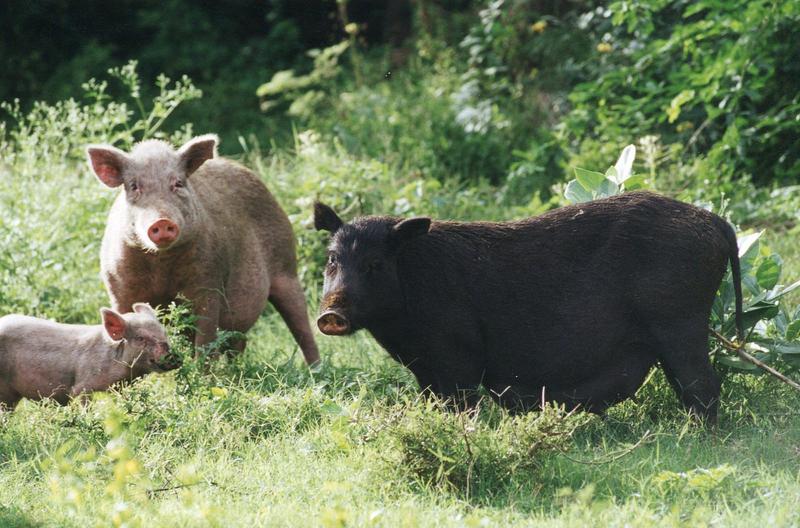
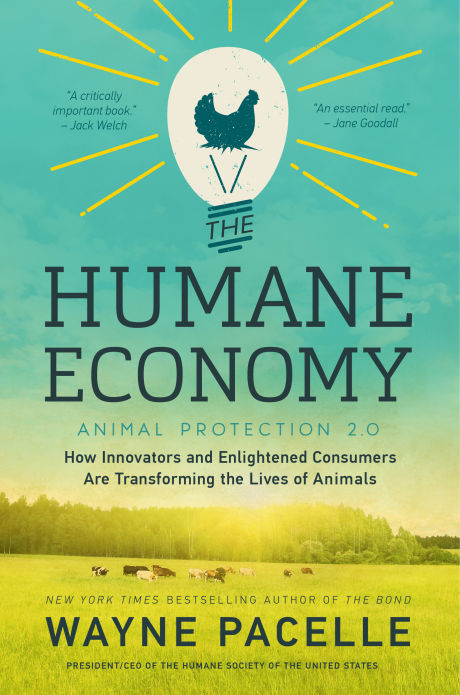
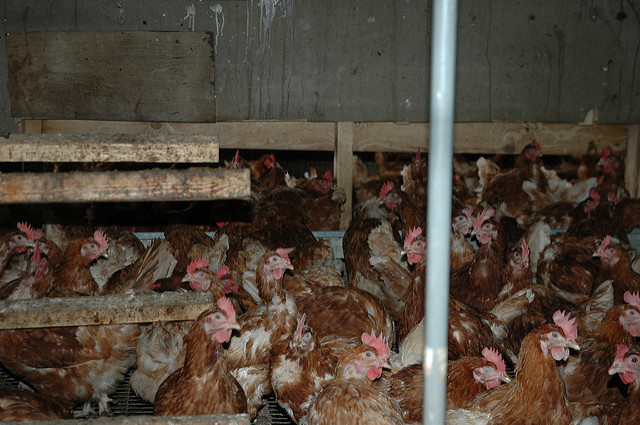
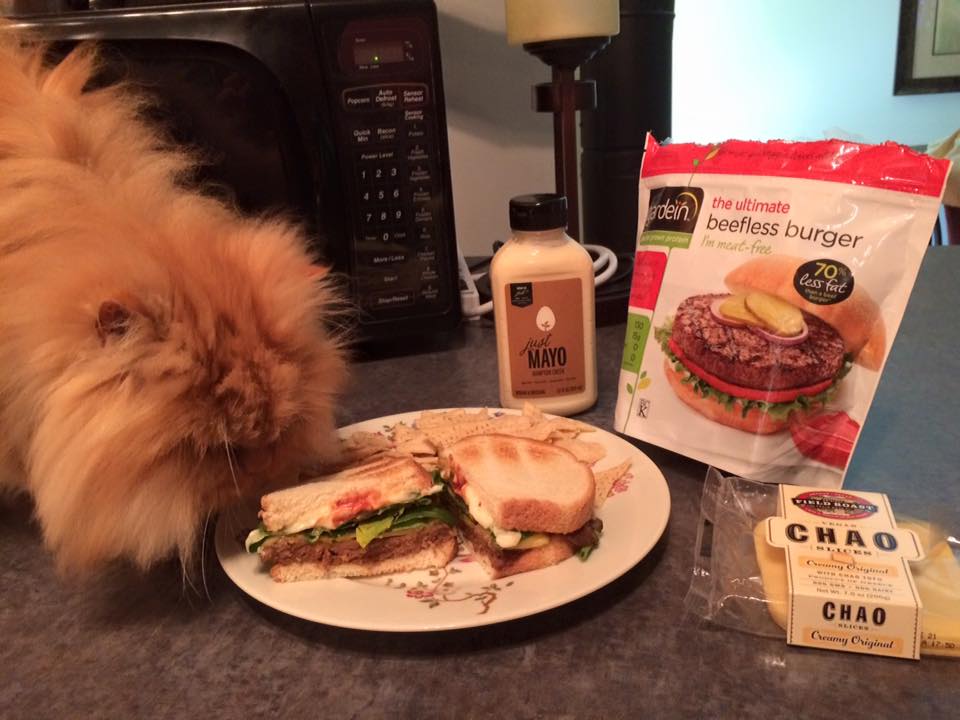





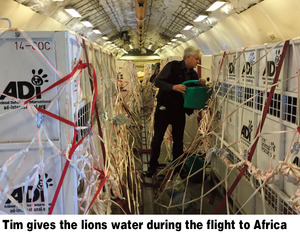 Their journey home was certainly epic! Beginning on Thursday morning, the first nine lions were loaded into their travel crates in Bucaramanga, Colombia, before travelling to Bogota by truck. The same night our 24 rescued lions in Peru were loaded and taken to Lima airport, where in the early hours, they joined the nine lions on the huge MD11 aircraft for their trans-Atlantic flight.
Their journey home was certainly epic! Beginning on Thursday morning, the first nine lions were loaded into their travel crates in Bucaramanga, Colombia, before travelling to Bogota by truck. The same night our 24 rescued lions in Peru were loaded and taken to Lima airport, where in the early hours, they joined the nine lions on the huge MD11 aircraft for their trans-Atlantic flight. With all of the animals relocated to their forever homes, we are now gearing up for Phase 2 of the lions’ habitats.
With all of the animals relocated to their forever homes, we are now gearing up for Phase 2 of the lions’ habitats. 







